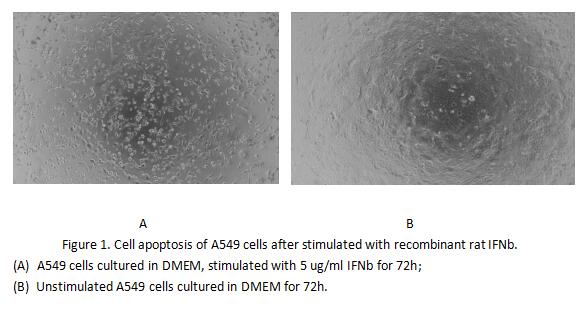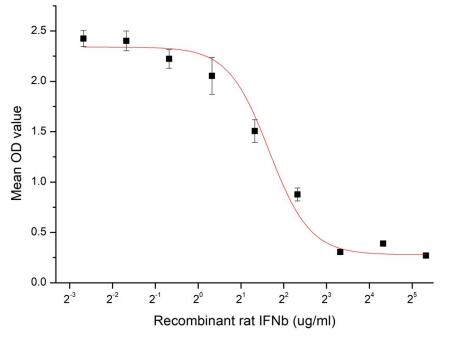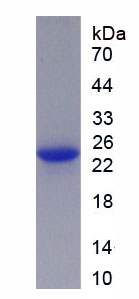Active Interferon Beta (IFNb) 

IFNB1; IFN-B; IFB; IFF; IFNB; Interferon Beta 1 Fibroblast
- UOM
- FOB US$ 244.00 US$ 610.00 US$ 1,220.00 US$ 3,660.00 US$ 9,150.00
- Quantity
Overview
Properties
- Product No.APA222Ra02
- Organism SpeciesRattus norvegicus (Rat) Same name, Different species.
- ApplicationsCell culture; Activity Assays.
Research use only - DownloadInstruction Manual
- CategoryCytokineTumor immunityInfection immunity
- Buffer FormulationPBS, pH7.4, containing 0.01% SKL, 5% Trehalose.
- Traits Freeze-dried powder, Purity > 95%
- Isoelectric Point9.6
Sign into your account
Share a new citation as an author
Upload your experimental result
Review

Contact us
Please fill in the blank.
Activity test

Interferon Beta (IFNb) is belongs to type I interferons (IFNs) family which a large subgroup of interferon proteins that help regulate the activity of the immune system.The IFNb proteins are produced in large quantities by fibroblasts. They have antiviral activity that is involved mainly in innate immune response. Two types of IFNb have been described, IFNb1 (IFNB1) and IFNb3 (IFNB3). IFNb1 is used as a treatment for multiple sclerosis as it reduces the relapse rate. To test the effect of IFNb on cell apoptosis, A549 cells were seeded into triplicate wells of 96-well plates at a density of 4,000 cells/well and allowed to attach overnight, then the medium was replaced with various concentrations of recombinant rat IFNb diluted with 5% serum standard DMEM. After incubated for 72h, cells were observed by inverted microscope and cell proliferation was measured by Cell Counting Kit-8 (CCK-8). Briefly, 10 µl of CCK-8 solution was added to each well of the plate, then the absorbance at 450 nm was measured using a microplate reader after incubating the plate for 1-4 hours at 37 ℃. Apoptosis of A549 cells after incubation with IFNb for 72h observed by inverted microscope was shown in Figure 1. Cell viability was assessed by CCK-8 (Cell Counting Kit-8 ) assay after incubation with recombinant rat IFNb for 72h. The result was shown in Figure 2. It was obvious that IFNb significantly decreased cell viability of A549 cells. The ED50 is 3.15 μg/mL.

Figure 2. Cell apoptosis of A549 cells after stimulated with recombinant rat IFNb.
Usage
Reconstitute in 10mM PBS (pH7.4) to a concentration of 0.1-1.0 mg/mL. Do not vortex.
Storage
Avoid repeated freeze/thaw cycles. Store at 2-8°C for one month. Aliquot and store at -80°C for 12 months.
Stability
The thermal stability is described by the loss rate. The loss rate was determined by accelerated thermal degradation test, that is, incubate the protein at 37°C for 48h, and no obvious degradation and precipitation were observed. The loss rate is less than 5% within the expiration date under appropriate storage condition.
Increment services
-
 BCA Protein Quantification Kit
BCA Protein Quantification Kit
-
 Molecular Mass Marker for Protein
Molecular Mass Marker for Protein
-
 Monoclonal Antibody Customized Service
Monoclonal Antibody Customized Service
-
 Polyclonal Antibody Customized Service
Polyclonal Antibody Customized Service
-
 Protein Activity Test Experiment Service
Protein Activity Test Experiment Service
-
 Electrophoretic Mobility Shift Assay (EMSA) Experiment Service
Electrophoretic Mobility Shift Assay (EMSA) Experiment Service
-
 Buffer
Buffer
-
 Lentivirus Packaging Experiment Service
Lentivirus Packaging Experiment Service
-
 Adenovirus Packaging Experiment Service
Adenovirus Packaging Experiment Service
-
 Real Time PCR Experimental Service
Real Time PCR Experimental Service
-
 Spike RBD Protein (S-RBD)
Spike RBD Protein (S-RBD)
-
 Protein G
Protein G
-
 Protein A
Protein A
Citations
- Melatonin protects liver against ischemia and reperfusion injury through inhibition of toll-like receptor signaling pathwayPubMed: 21355876
- Hepatitis B virus polymerase inhibits RIG-I- and Toll-like receptor 3-mediated beta interferon induction in human hepatocytes through interference with interferon regulatory factor 3 activation and dampening of the interaction between TBK1/IKKε and DDX3.Sgm: 9182080
- Impaired TLR3/IFN-β signaling in monocyte-derived dendritic cells from patients with acute-on-chronic hepatitis B liver failure: Relevance to the severity of liver damageScienceDirect: S0006291X09019822
- Intact Type I Interferon Production and IRF7 Function in Sooty MangabeysPubMed: PMC3757038
- Innate Immune Response to Rift Valley Fever Virus in GoatsPubMed: PMC3335883
- Low pH Environmental Stress Inhibits LPS and LTA-Stimulated Proinflammatory Cytokine Production in Rat Alveolar MacrophagesPubmed: 24288685
- An attenuated EIAV strain and its molecular clone strain differentially induce the expression of Toll-like receptors and type-I interferons in equine monocyte-derived macrophages.Pubmed: 23850441
- Scoparone attenuates d-galactosamine/lipopolysaccharide-induced fulminant hepatic failure through inhibition of toll-like receptor 4 signaling in micePubmed: 23535186
- Experimental model of equine alveolar macrophage stimulation with TLR ligandsPubmed: 23815824
- Training Modifies Innate Immune Responses in Blood Monocytes and in Pulmonary Alveolar MacrophagesPubmed: 24502337
- Mannan binding lectin attenuates double-stranded RNA-mediated TLR3 activation and innate immunityPubmed:24530528
- Infection of equine monocyte-derived macrophages with an attenuated equine infectious anemia virus (EIAV) strain induces a strong resistance to the infection by a virulent EIAV strainPubmed:25106750
- MicroRNA-30e* Suppresses Dengue Virus Replication by Promoting NF-κB–Dependent IFN ProductionPubmed:25122182
- The innate immune response of equine bronchial epithelial cells is altered by trainingPubmed:25595212
- SOCS3 Drives Proteasomal Degradation of TBK1 and Negatively Regulates Antiviral Innate ImmunityPubMed: 25939384
- Analysis of cytokine production in a newly developed canine tracheal epithelial cell line infected with H3N3 canine influenza virusPubMed: 25797196
- Complexes of DNA with the Antimicrobial Peptide LL37 Augment NK Cell Functions by Inducing Type I Interferon Production from Circulating Monocytes and Plasmacytoid Predendritic CellsPubMed: 26258404
- PKR activation enhances replication of classical swine fever virus in PK-15 cellsPubMed: 25899421
- siRNA Targeting the 2A pro Genomic Region Prevents Enterovirus 71 Replication In VitroPubmed:26886455
- Cellular uptake of exogenous calcineurin B is dependent on TLR4/MD2/CD14 complexes, and CnB is an endogenous ligand of TLR4Pubmed:27090571
- Innate Immune Responses in ALV-J Infected Chicks and Chickens with Hemangioma In VivoPubmed:27252695
- Chloroquine attenuates lipopolysaccharide-induced inflammatory responses through upregulation of USP25.pubmed:28134560
- Effects of IRF1 and IFN-β interaction on the M1 polarization of macrophages and its antitumor functionpubmed:27176664
- Host miR-146a promotes replication of human cytomegalovirus by suppressing type I IFN response in MRC-5 cellsfiles:ijcep0036479.pdf
- ALV-J strain SCAU-HN06 induces innate immune responses in chicken primary monocyte-derived macrophagespubmed:27486255
- Characterization of Simian Immunodeficiency Virus Variants Anatomically Compartmentalized inPlasma and Milk in Chronically Infected African Green Monkeys.pubmed:
- MicroRNA-548j inhibits type I interferon production by targeting ZBTB11 in patients with chronic hepatitis Bpubmed:28342861
- The down-regulation of casein kinase 1 alpha as a host defense response against infectious bursal disease virus infectionpubmed:28988058
- Zika virus elicits inflammation to evade antiviral response by cleaving cGAS via NS1‐caspase‐1 axisPubmed:30065070
- Bisphenol A induced male germ cell apoptosis via IFNβ-XAF1-XIAP pathway in adult micePubmed:30017639
- MAVS induces a host cell defense to inhibit CSFV infectionPubmed:29556776
- Inhibition of DNA-sensing pathway by Marek's disease virus VP23 protein through suppression of interferon regulatory factor 7 activationPubmed: 30518647
- Molecular cloning and functional characterization of porcine 2′, 5′-oligoadenylate synthetase 1b and its effect on infection with porcine reproductive and respiratory?…Doi: 10.1016/j.vetimm.2019.01.003
- HIPK2 is necessary for type I interferon–mediated antiviral immunityDoi: 10.1126/scisignal.aau4604
- Evaluation of serum interferons in patients with age-related macular degenerationPubmed: 31007694
- Differential expression of type I interferon mRNA and protein levels induced by virulent Marek's disease virus infection in chickens
- Porcine FcγRIIb mediated PRRSV ADE infection through inhibiting IFN-β by cytoplasmic inhibitory signal transductionPubmed: 31284005
- Marek's Disease Virus RLORF4 Inhibits Type I Interferon Production by Antagonizing NF-κB ActivationPubmed: 31243133
- Serodiagnosis of Human Bocavirus 1 Infection among Hospitalised Children with Lower Respiratory Tract Infection in Latvia
- The immunostimulatory effects and pro‐apoptotic activity of rhCNB against Lewis lung cancer is mediated by Toll‐like receptor 4Pubmed: 31218844
- Scavenger receptor A impairs interferon response to HBV infection by limiting TRAF 3 ubiquitination through recruiting OTUB 1
- Avian oncogenic herpesvirus antagonizes the cGAS-STING DNA-sensing pathway to mediate immune evasionPubmed: 31539404
- Induction of autophagy and suppression of type I IFN secretion by CSFVPubmed: 32160078
- BVDV-1 induces interferon-beta gene expression through a pathway involving IRF1, IRF7, and NF-κB activationPubmed: 33053462
- LDHB inhibition induces mitophagy and facilitates the progression of CSFV infectionPubmed: 32924761
- Infectious bronchitis virus inhibits activation of the TLR7 pathway, but not the TLR3 pathwayPubmed: 32532134
- Determination of antiviral action of Long Non-coding RNA loc107051710 During Infectious Bursal Disease Virus Infection due to Enhancement of Interferon …
- Transferrin-dependent crosstalk between the intestinal tract and commensal microbes contributes for immune tolerance
- Open reading frame 5 protein of porcine circovirus type 2 induces RNF128 (GRAIL) which inhibits mRNA transcription of interferon-β in porcine epithelial cells34416463
- Anti‐IFN‐α/‐ω neutralizing antibodies from COVID‐19 patients correlate with downregulation of IFN response and laboratory biomarkers of disease severityPubmed:35419822
- Chicken Intestinal Microbiota Modulation of Resistance to Nephropathogenic Infectious Bronchitis Virus Infection Through IFN-I







